
the fourth of July
with uncle sam
In honor of the Fourth of July holiday, the NMAI has assembled a selection of Patriotic images.
Along with reflections of traditional celebrations of this American holiday, we also explore the evolving images of American patriotism through the artworks of World War I and World War II. From War Bond sales and recruitment posters to magazine covers, the American public has long been intrigued by the idea of patriotism and the illustrators that created these most American of images.
We wish all Illustration fans a wonderful holiday celebrating the patriotic history of the United States!

J.C. Leyendecker (1874-1951)
The Fourth of July Lamppost
1937, oil on canvas
31 1/2" x 24 1/4", signed lower right
Saturday Evening Post, July 3, 1937 cover
For the Independence Day issue of the Saturday Evening Post in 1937, Leyendecker imagined two boys scaling a lamppost to catch a glimpse of the parade passing down Main Street. While the boy on the right doffs his cab exuberantly as the American flag passes by, the boy on the left clings precariously to the post and glances down at the ground with a fearful expression. The two models were Howard Davenport, Jr. on the right and Earl Williams on the left. They later recalled the arduous task of posing for Leyendecker over the course of several sessions and the numerous changes that the artist made to the final composition. In particular, Earl Williams was instructed "to look down as if I was scared," tempering the image's patriotic triumphalism with a hint of unease for this African American boy and his tenuous position on Main Street.

James Montgomery Flagg (1877-1960)
Columbia
1916, watercolor on paper
28” x 21”, signed lower right
Leslie's Magazine cover
World War I poster
The week after the United States declared war on Germany in April 1917, in response to Germany's unrestricted submarine warfare sinking of US merchant ships, President Woodrow Wilson formed the Committee on Public Information (CPI). As a member of the CPI, between the years of 1917 and 1919, Flagg produced forty-six posters for the United States government, including the iconic image of Uncle Sam telling his viewers "I Want You!", and Columbia, seen here. In Columbia, Flagg depicts Lady Liberty calling Americans to arms by land and by sea to help support the war effort in Europe.
J.C. Leyendecker (1874-1951)
Uncle Sam with Rifle
1916, oil on canvas
30" x 21", signed lower right
Saturday Evening Post, July 1, 1916 cover
Painted in the midst of World War I, Leyendecker highlighted the political and emotional turmoil Americans were facing for this 1916 Fourth of July cover. Leyendecker depicts Uncle Sam, adorned in clothes of the American Flag, literally taking up arms with great sadness and hardship. This cover certainly reflected the way the country felt about sacrificing its own in the War. The United States ultimately entered the War in April 1917, sending troops to Europe.

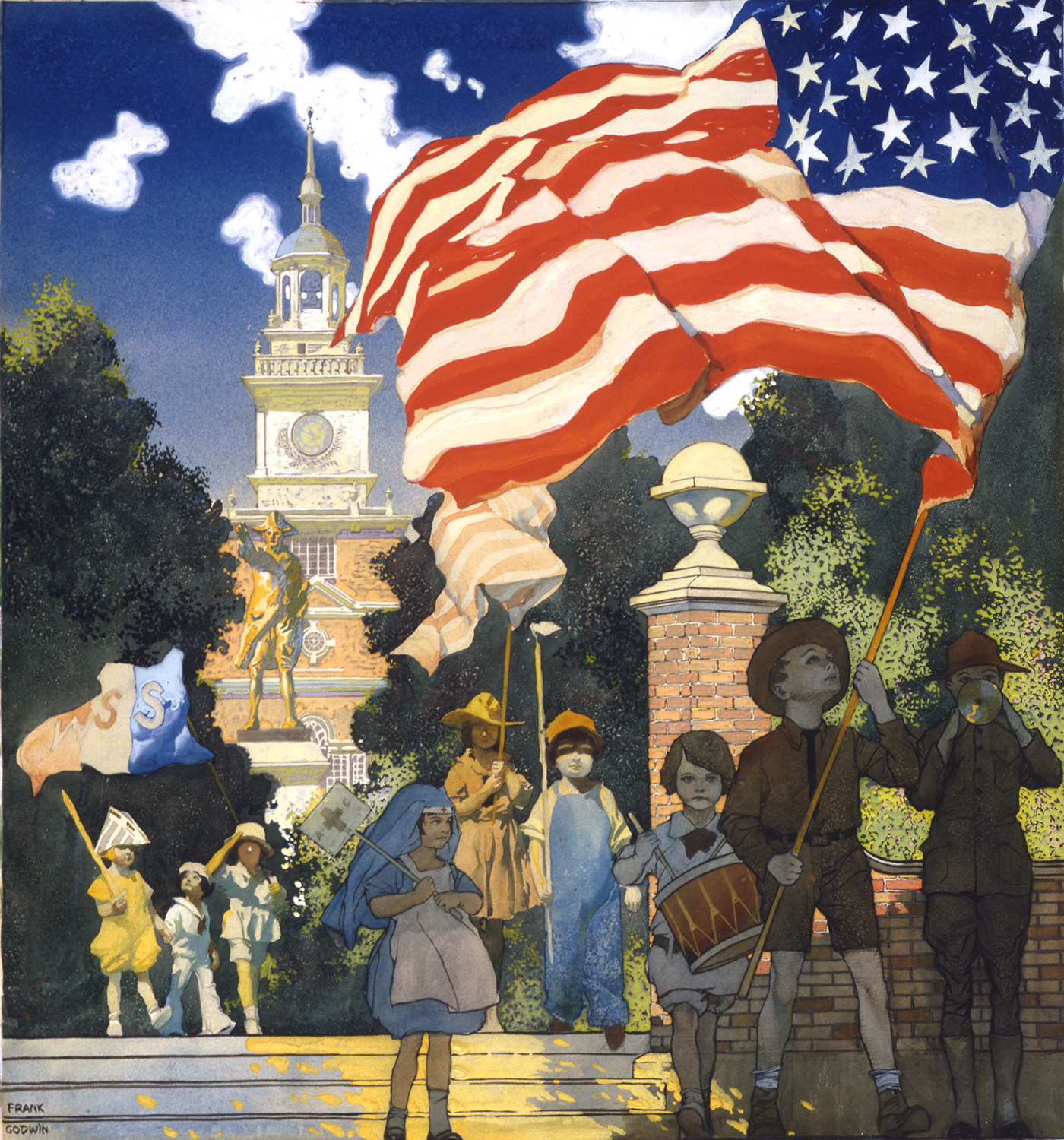
Frank Godwin (1889-1959)
Philadelphia Patriotic Scene
1917, gouache on board
18 1/2" x 17", signed lower left
World War I poster - War Savings Stamps Drive
A member of the CPI, Frank Godwin painted this celebratory scene of Philadelphia for the War Savings Stamps Drive to rally support from the youth of America. War Savings Stamps were issued by the United States Treasury Department to help fund the war effort. These stamps were primarily targeted to the average American and were an inexpensive way to support the troops.
Cushman Parker (1881-1940)
Little Americans: Do Your Bit
1917, oil on canvas
18” x 18”, signed lower right
United States Food Administration poster, 1918-1919
When the United States entered into World War I, the United States Food Administration was formed to control the production, distribution and conservation of food in the country for the duration of the War. The agency had broad powers but few mechanisms for enforcement of its policies, and therefore relied heavily on patriotic appeals and voluntary compliance. To do so, a large advertising campaign was launched to bolster support of the absences and rations felt across the country. Cushman Parker created this charming image of a boy happily saluting his cereal, leading by example to "Do Your Bit" at home by following the necessary Administration's rules.
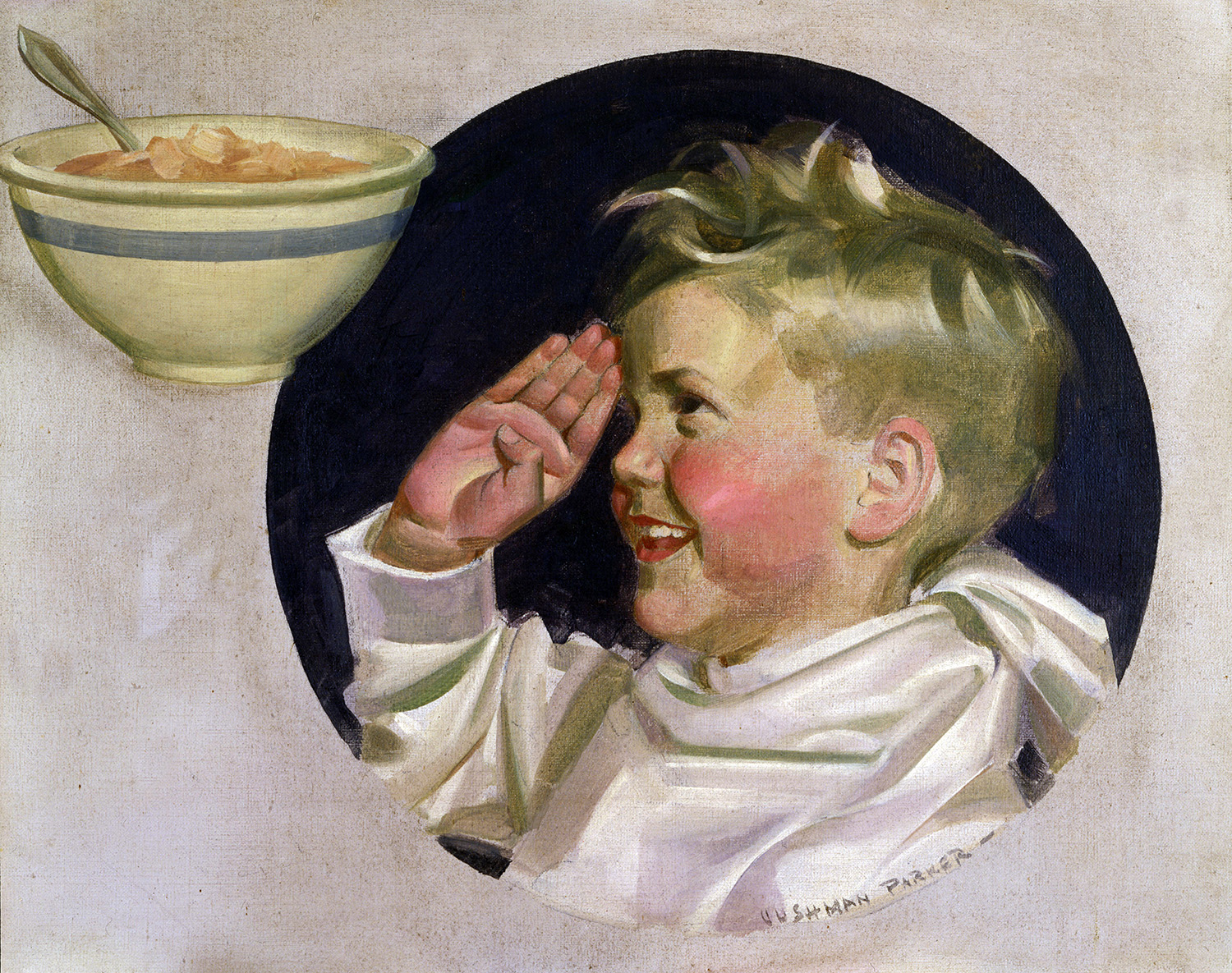
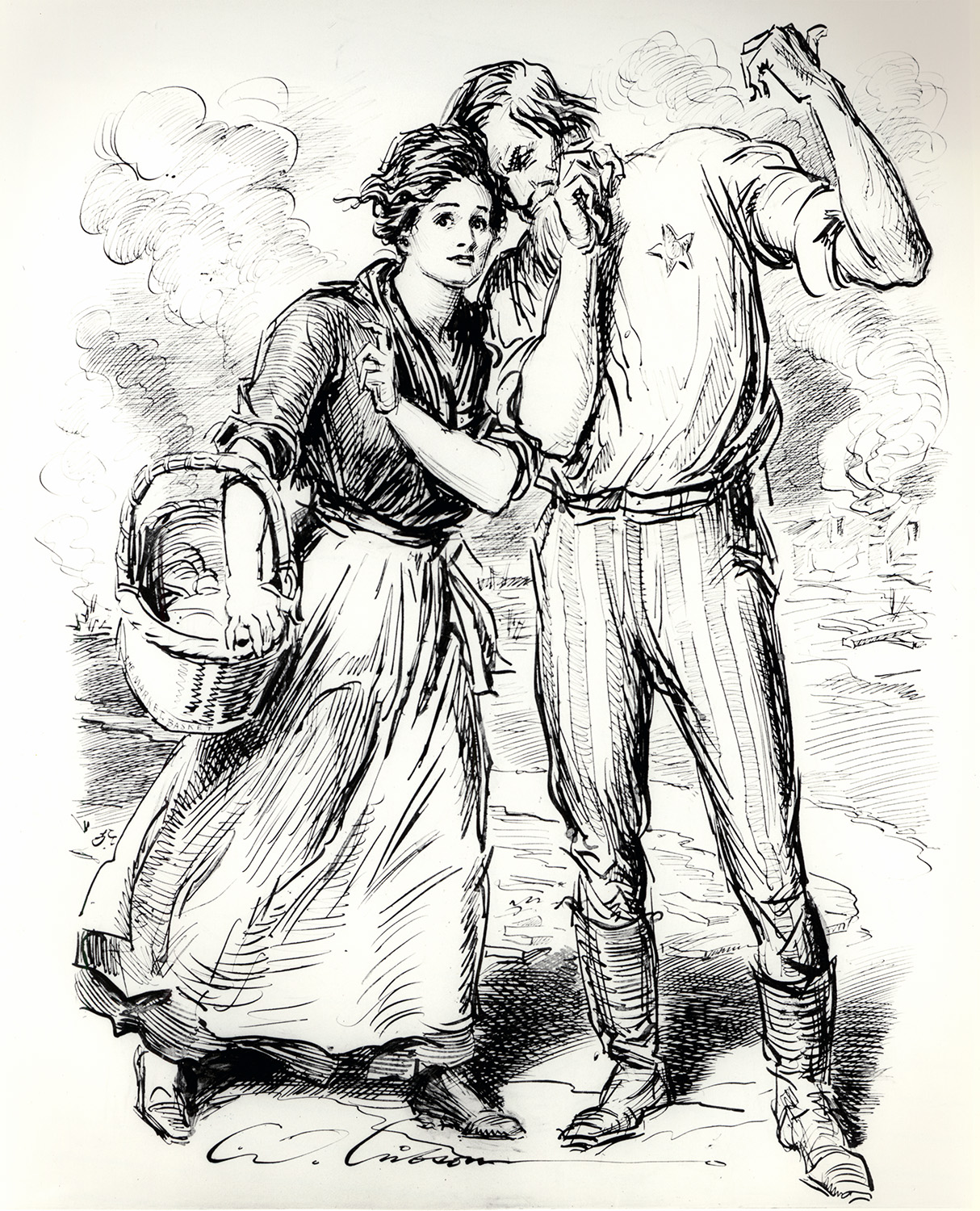
Charles Dana Gibson (1867-1944)
A Word to the Wives: Save! (The Market Basket)
1918, pen and ink
29 7/8” x 24”, signed lower right
Red Cross Magazine, January 18, 1918 frontispiece
World War I food poster
When President Wilson formed the Committee on Public Information (CPI), he selected famed illustrator Charles Dana Gibson to lead the effort. In 1918, Gibson remarked that "It is the greatest opportunity the artists have ever had to serve their country". The CPI eventually included over 300 artists, all of whom were unpaid volunteers, and created more than 1,400 designs, ranging in purpose from fund raising to recruiting personnel for the military to conservation of food and other commodities, as is the use for this poster illustration. Gibson depicts Uncle Sam himself whispering to a young woman on her way to the market, reminding her to conserve what she purchases to support the troops abroad.
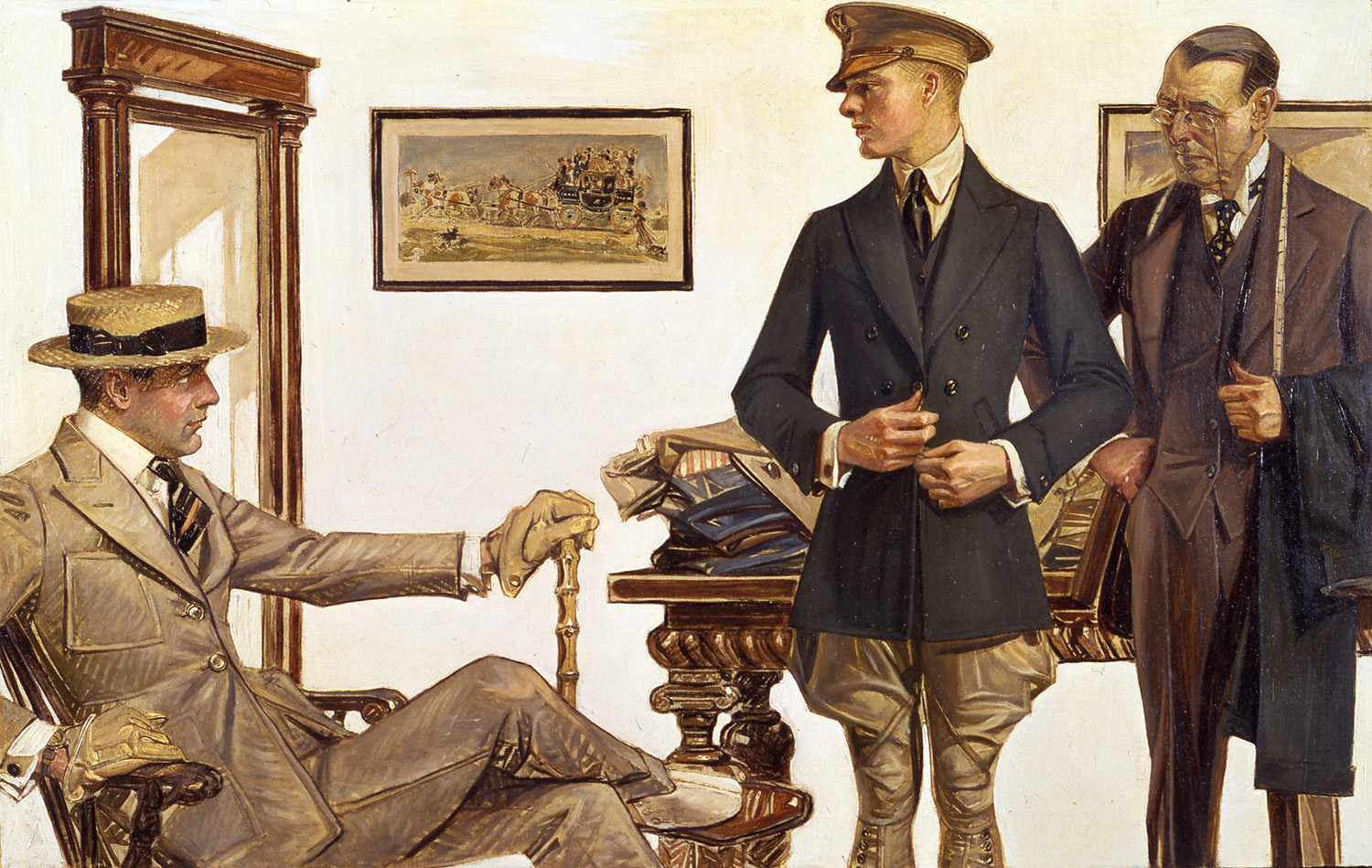
J.C. Leyendecker (1874-1951)
A Fitting - Kuppenheimer Good Clothes
1918, oil on canvas
22" x 30”
House of Kuppenheimer advertisement
Founded in 1852 in Leyendecker's hometown of Chicago, House of Kuppenheimer was a premiere men's clothing manufacturer and retailer. Leyendecker illustrated for Kuppenheimer for most of his career and created stunning illustrations of beautifully dressed men to sell the clothing. When the United States entered World War I, Kuppenheimer manufactured the uniforms for the Army, and Leyendecker created the images to go along with them.
Norman Rockwell (1894-1978)
Uncle Sam
1918, oil on canvas
29” x 21”, signed lower right
Red Cross Magazine, April, 1918 cover
Charles Dana Gibson recruited a team of the most renowned "landscape painters, mural decorators, architects, painters, illustrators, sculptors, and so on" to create the Committee on Public Information (CPI). This included illustrators Howard Chandler Christy, Harrison Fisher, James Montgomery Flagg, N.C. Wyeth, and a very young Norman Rockwell. At just 24 years of age Rockwell painted this Red Cross Magazine depicting Uncle Sam as a marching band major, leading an endless parade of children to support the war effort. As the cover of Red Cross Magazine, the image encourages children across the country to volunteer at home to contribute to the nation's fight.
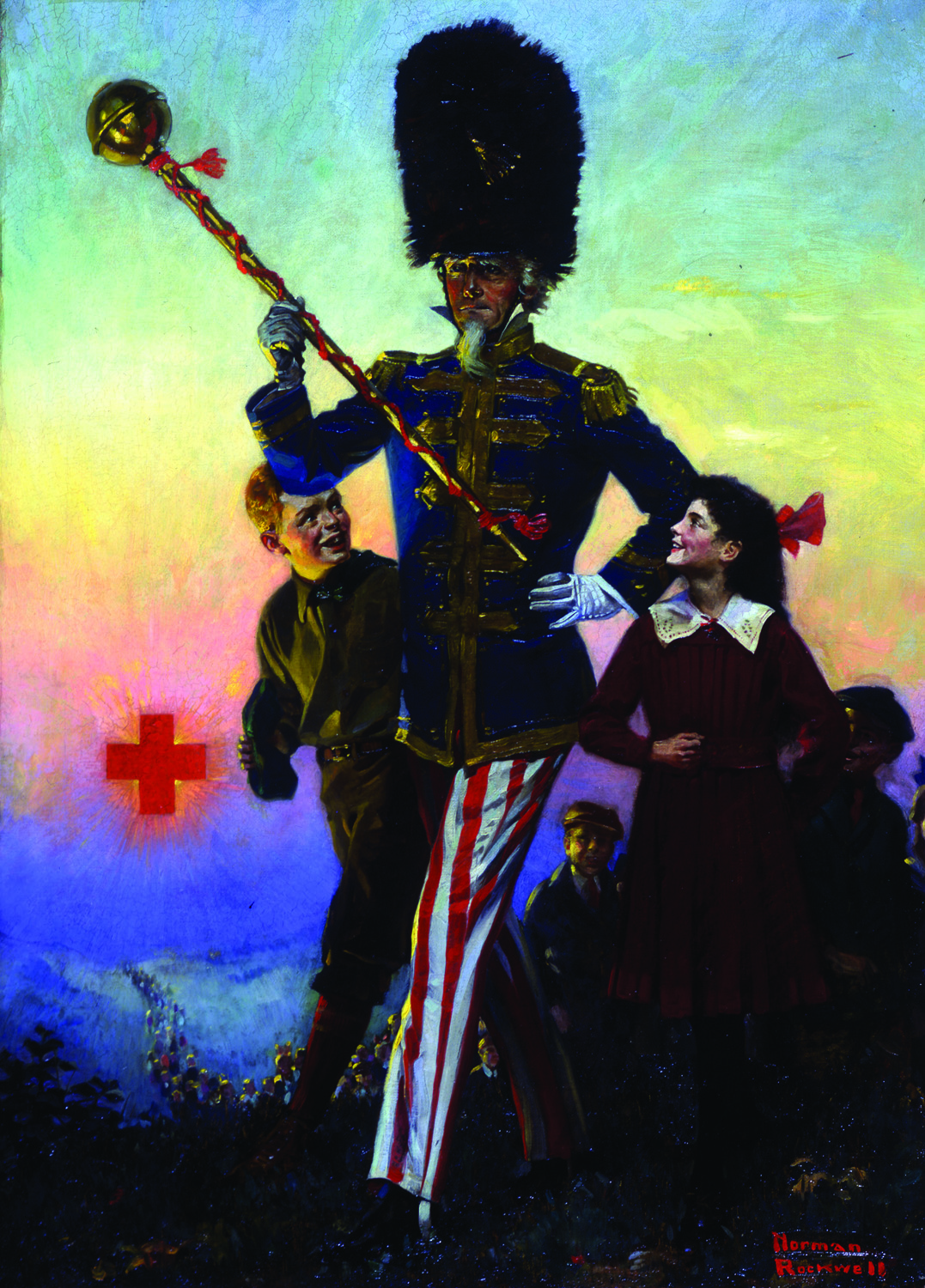
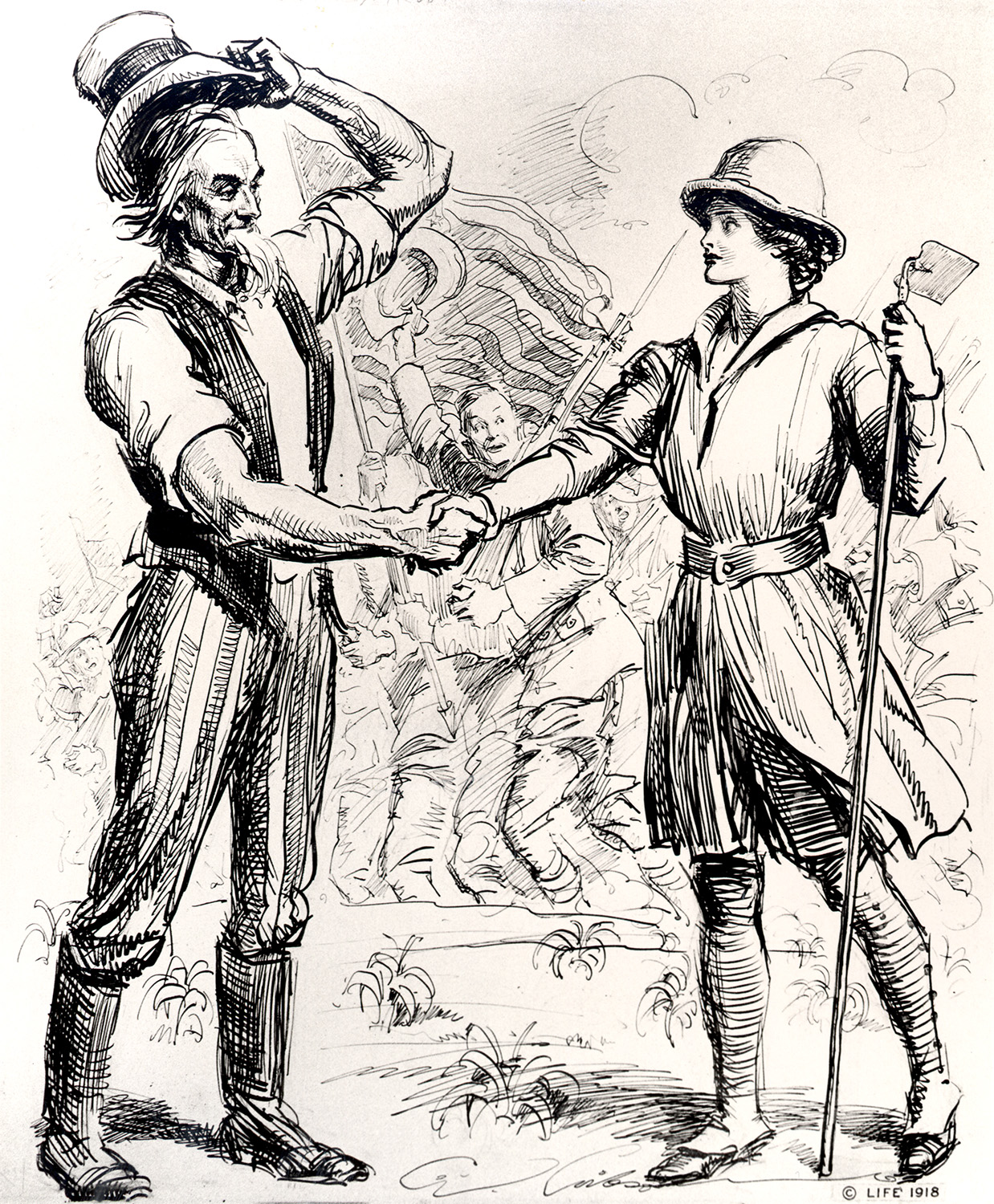
Charles Dana Gibson (1867-1944)
Help! The Women's Land Army of America
1918, pen and ink on board
23 1/4" x 19 1/4", signed lower center
Life Magazine, May 23, 1918 cover
World War I poster
Gibson saw the War as an event that changed his worldview and should similarly serve as a pivotal point in the lives of his fellow citizens. He explained, "We can no longer be content with the things and conditions we formerly accepted. We are beginning to be more unselfish. We are not so grouchy, nor impatient. We begin to feel that there are great sacrifices ahead. We are preparing for them. There can be no peace of mind to any artist unless he can find a way to contribute to the country." For this poster and cover illustration, Gibson encourages the women left at home to pick up the men's jobs until they return from overseas to help the country continue forward during wartime. He includes a background of young men at war charging forward as a reminder to the viewer of what every sacrifice and effort at home is supporting.
Griswold Tyng (1883-1960)
World War I Uncle Sam
1918, crayon and gouache on board
38” x 28”, signed lower left
Possible World War I poster
During both World War I and II, Griswold Tyng served as an official artist for the United States Army. In this artwork Tyng created a classic Uncle Sam image looking proudly forward, with camouflaged battleships in the background, ready to take on the task at hand with his rifle and equipment in tow. A woman wearing the crown of civilization soars above him with a guiding light, encouraging him to bravely conquer his enemies.
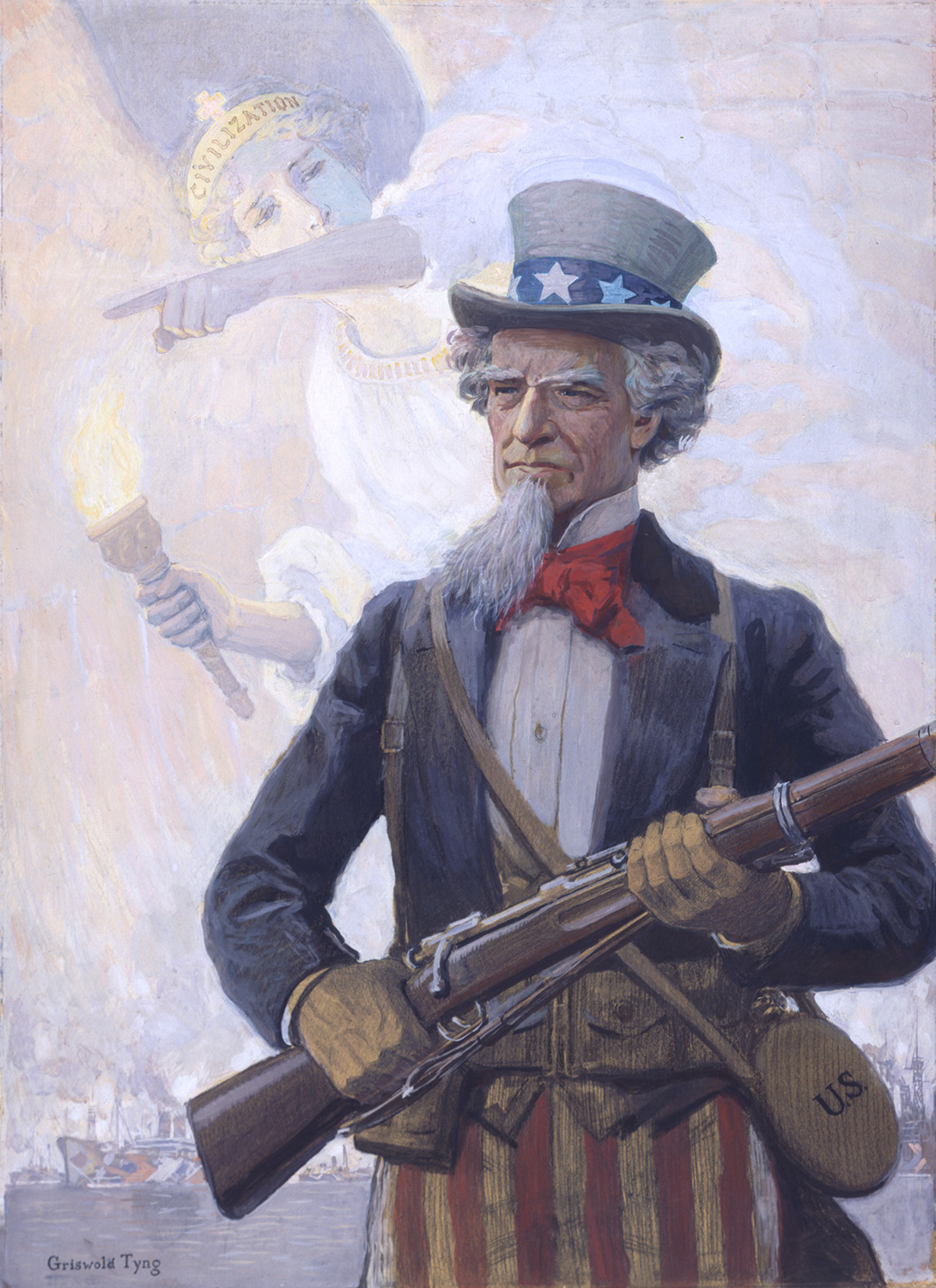

Paul Stahr (1883-1953)
The Lost Man of War
1918, watercolor with opaque white highlights
30" x 22", signed lower left
Life Magazine, July 11, 1918 cover
A German American immigrant from New York City, Paul Stahr supported the American war effort with poster illustrations for Liberty Loans, Red Cross, National Defense, and the Hoover Food Administration. This July 11, 1918 cover for Life Magazine is a lighthearted depiction of a soldier who was lost in the war finally returning home. Two young women excitedly serve tea and biscuits to the young man, hoping to win the returned hero's favor.
Howard Chandler Christy (1873-1952)
Stand By Your President - Dawn of Victory
1933, oil on canvas
60” x 40”, signed and dated lower left
Re-Elect Herbert Hoover campaign poster illustration
Painted for a Herbert Hoover's re-election campaign poster, Howard Chandler Christy's allegorical image memorializing significant historical events asks voters to "Stand By Your President" in the midst of the Great Depression. An angelic woman draped in red, white, and blue fabric rides on the wings of an eagle, carrying a plentiful horn of fruit symbolizing prosperity in one arm and raising a crown of victory above her head. In the lower right corner scared, hungry wolves are cowering away from the powerful blue-gray eagle (a symbol of the National Recovery act) readying to fight them off. On the other side of the wolves, a man stands in the doorway of American industry. Behind him in the distance are fully operational smoke stacks representing the booming commercial production and economic activity. Christy's use of symbolism in this poster made it an enduring image of Hoover's campaign and of the struggles of the Great Depression. Hoover ultimately lost the election to Franklin D. Roosevelt, who served as President until 1945.
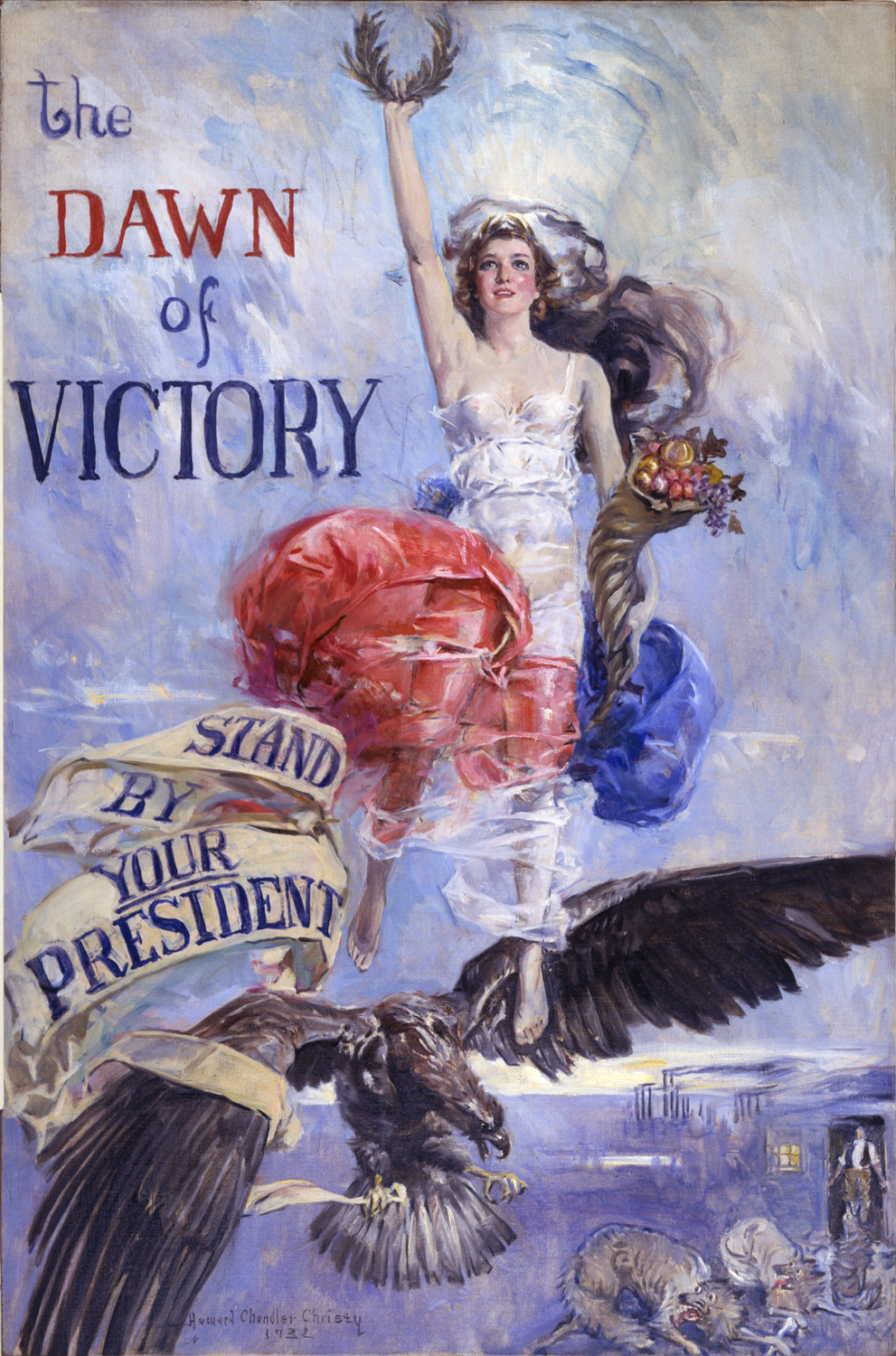

Leslie Thrasher (1889-1936)
The Patriot
1931, oil on canvas
18” x 16”, signed lower right
Liberty Magazine, July 4, 1931 cover
This touching Fourth of July Liberty Magazine cover highlights the importance to remember those who have served the country through military service, and ultimately lost their lives. Leslie Thrasher depicts a young boy in a newspaper military hat and sash of an American flag saluting the service flag his family has hanging in the window, indicating a lost life in military action. First used in World War I, these flags symbolize a family's sacrifice through personal loss to the country.
Leslie Thrasher painted one cover a week for six years for Liberty Magazine. On these covers, Thrasher followed the same characters in a small town throughout the years, inviting the reader to follow along with their stories each week. The series, titled "For the Love o'Lil," made Thrasher famous. His covers became so popular it was later made into a movie by Columbia Pictures and is considered the prototype for today's soap operas.
George Brehm (1878-1966)
The Junior Red Cross
c. 1940, oil on canvas
30” x 28”, signed lower left
Beginning in World War I, the Junior Red Cross provided a place for children to contribute to the war effort. After the war the program continued, raising funds, supplies, and support for conflicts around the United States and abroad, providing aid during natural disasters, the Great Depression, and pandemics across Europe and America. During World War II the Junior Red Cross' membership grew to almost 20 million youths. George Brehm's image depicts a young boy and girl proudly holding the American Flag, with the young boy inviting the viewer to come join them in supporting the country.
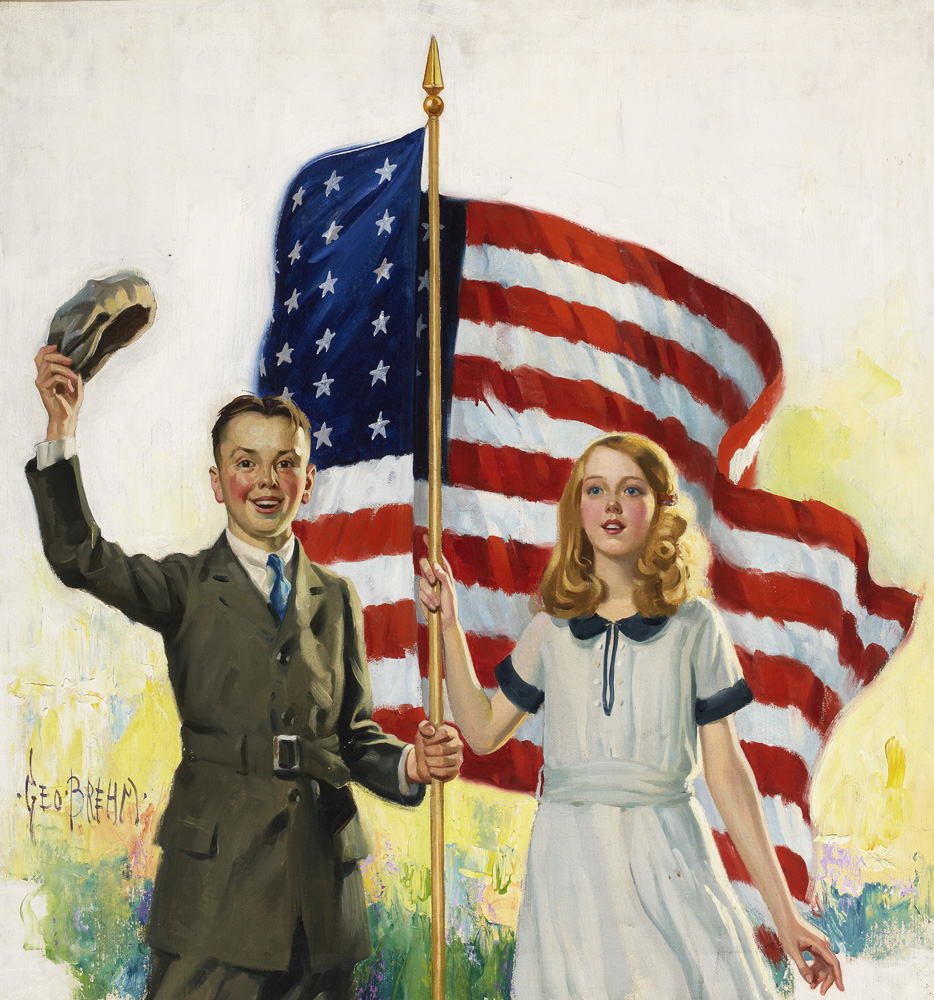
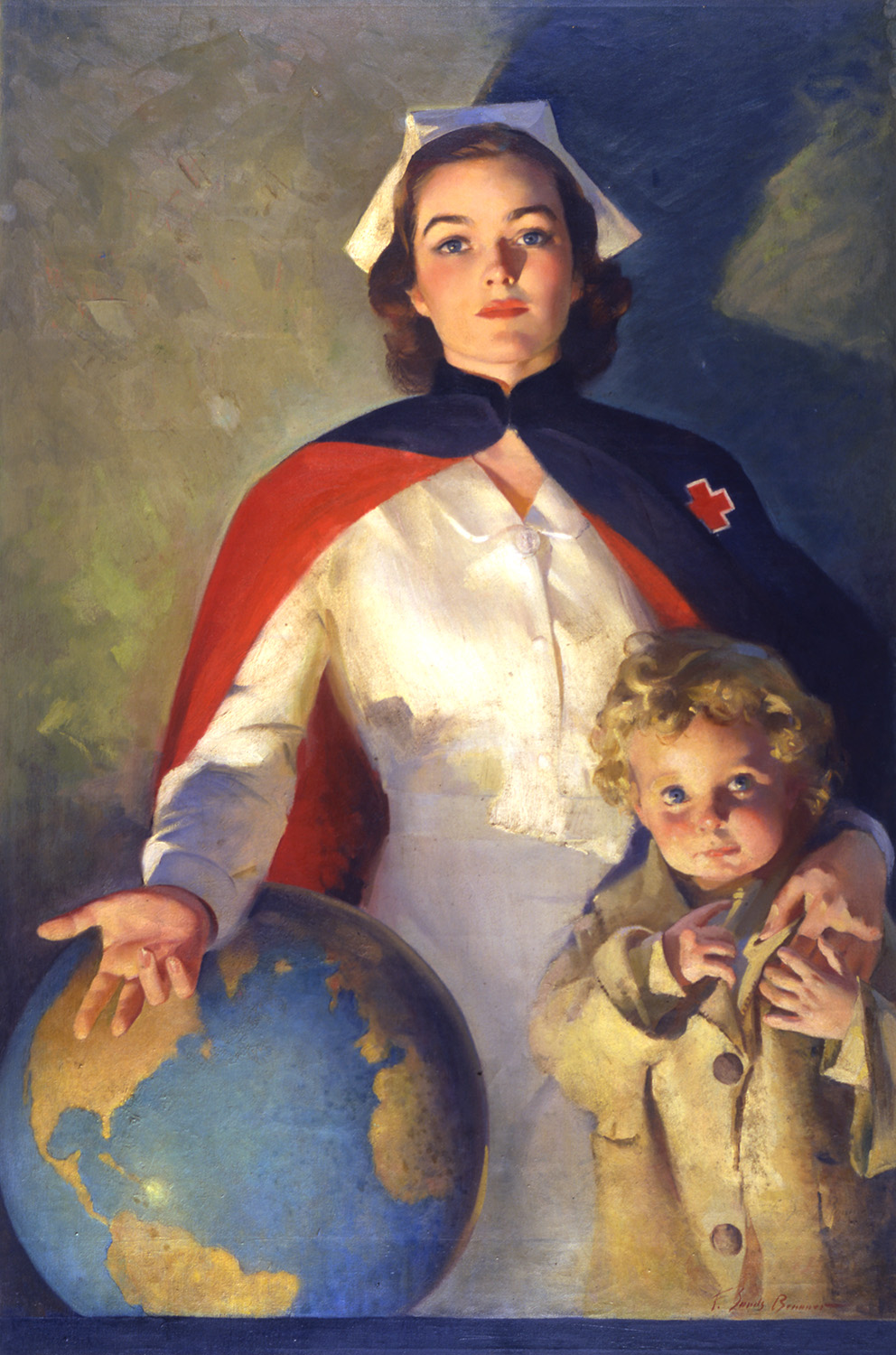
Frederick Sands Brunner (1886-1954)
Red Cross Serving the Children of the World
1942, oil on canvas
45” x 32”, signed lower right
Possible World War II poster
When hostilities began in Europe in 1939, the Red Cross became the chief provider of relief supplies for the civilian victims of conflict distributed by the Geneva-based International Red Cross Committee. In February 1941, the Red Cross began a Blood Donor Service to produce lifesaving plasma for the armed forces, and after the December 7, 1941 attack on Pearl Harbor, the Red Cross quickly mobilized a volunteer and staff force to fulfill its mandates to "furnish volunteer aid to the sick and wounded of armies in time of war." To raise donations and encourage volunteers, the Red Cross enlisted many illustrators to create imagery to support their cause. This image of a nurse in white with outstretched arms was a common theme in many of these advertisements, asking the viewer to help further their cause to support the war effort.
John Falter (1910-1982)
Ninety-Day Wonder
1943, oil on board
24" x 20", signed lower right
Saturday Evening Post, July 10, 1943 cover
John Falter illustrated this 1943 Saturday Evening Post cover to honor the "Ninety-Day Wonder," an officer commissioned in a branch of the armed forces after an unusually short training period, particularly after a three-months officers' training course during World War II. The handsome young man has put on his new officer's uniform and tossed his enlistment uniform, which is no longer needed, across the chair. Falter depicts him with a confident stance with gaze looking forward, ready to tackle any challenges that face him in the escalating war in Europe.


Norman Rockwell (1894-1978)
Miss Liberty
1943, oil on canvas
41 3/4” x 31 1/4”, signed lower right
Saturday Evening Post, September 4, 1943 cover
For this 1943 Saturday Evening Post Labor Day cover, Rockwell created a cultural icon of the time for America. Miss Liberty represents women of the 1940s who went to work for the first time taking over male-oriented jobs while the men fought overseas. Women suddenly fulfilled roles to which they never aspired, nor even envisaged before. In short, Miss Liberty is emblematic of her times and the liberation of women in the workplace. The Saturday Evening Post listed a number of occupations which were represented in Miss Liberty: gas station attendant, switchboard operator, grocery clerk, milk-woman, electrician, plumber, garage mechanic, stenographer, editor, reporter, baggage clerk, bus driver, railroad conductor, taxi driver, truck driver... Rockwell noted that "getting the props all together and arranging them on the model had presented quite a problem," perhaps the hardest part of creating this artwork for the master illustrator.
John Falter (1910-1982)
Put Them Across! The Toughest Job is Still Ahead!
1943, oil on canvas
32" x 25", signed lower right
Official Navy poster, United States Government Printing Office
Printed alongside a message from Admiral Ernest J. King, Commander in Chief of the United States Fleet and Chief of Naval Operations during World War II, John Falter created this dramatic poster illustration to rally support for the troops abroad. The soldiers walk up the gangway in the middle of the night, only illuminated by the lights of the ship in front of them, readying for battle. The message to viewers read: "To Fellow Americans Ashore: Let's waste no time... Put them across with ships, planes and guns... Stay on the job and deliver the goods - Gangway for Victory." The phrase "Gangway for Victory" was used as a rallying cry to support the troops at sea.
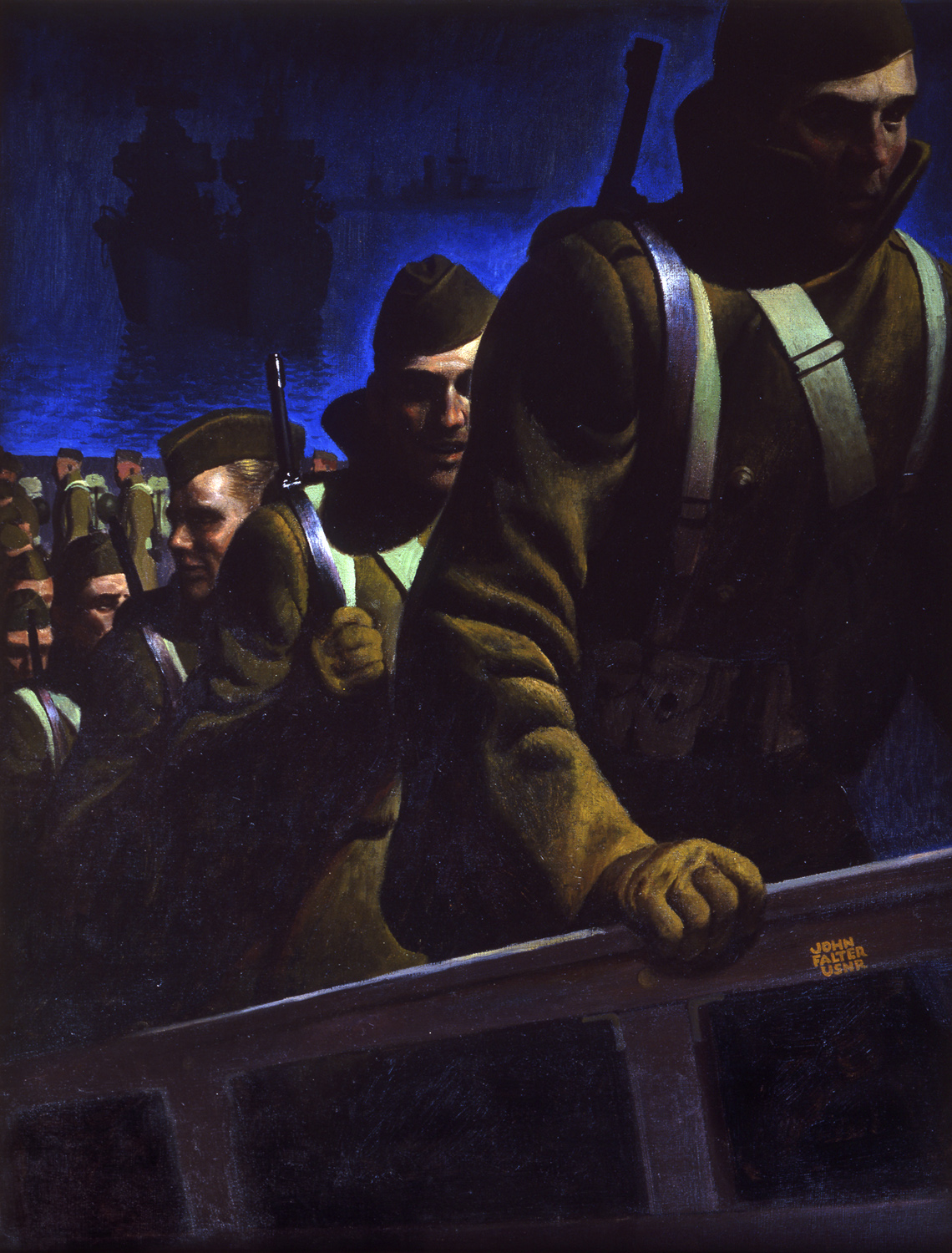
Norman Rockwell (1894-1978)
Disabled Veteran - Soldier and U.S. War Bond
1944, oil on canvas
43" x 34", signed lower right
Saturday Evening Post, July 1, 1944 cover
Rockwell's technique of placing a static figure in front of an action scene in this painting won him first prize from the Art Directors' contest in 1944. He later commented that he attributed this technique to the Old Masters, which gave life to an otherwise static setting. His somber palette added gravitas to the nature of war. The front figure holds the focus of the viewer and displays the ultimate reality of being wounded and returning home disabled. Rockwell used his Arlington neighbor, Roy Cole, who actually served in the 1st infantry division (the oldest division in the US Army) and returned home wounded. Roy's name and Arlington address are visible on the painted war bond.
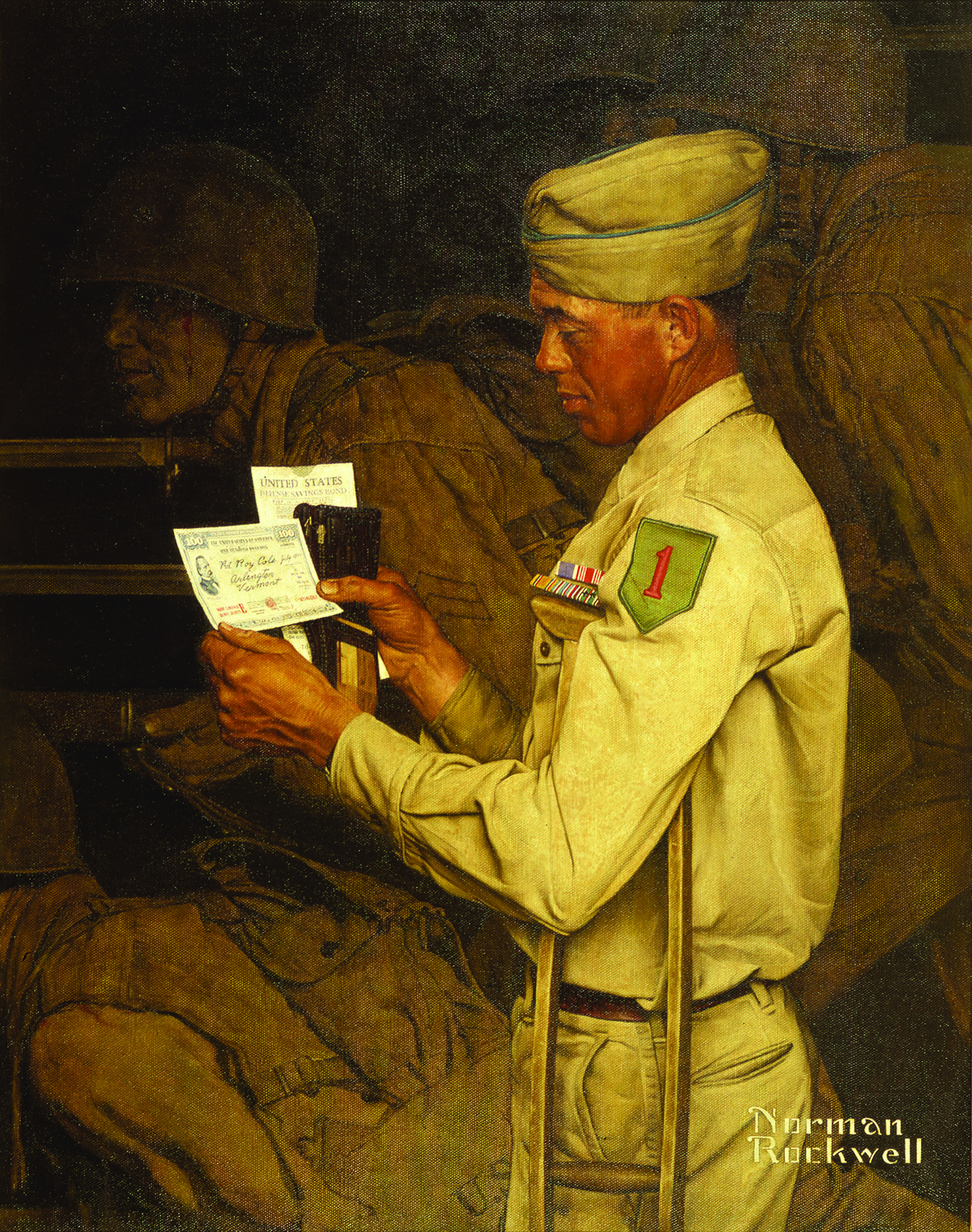

Howard Chandler Christy (1873-1952)
Freedom is Your Business
1950, oil on canvas
36” x 27”, signed lower left
United States Army recruitment poster, 1950
For this 1950 Army recruitment poster, Howard Chandler Christy chose to emphasize the legacy of generations of soldiers who have fought to establish the freedoms of United States. A young soldier dressed in a modern 1950's military uniform stands in the foreground with the ghostly images of soldiers from the Revolutionary War, the Civil War, World War I and World War II in the sky above him. This poster was intended to inspire subsequent generations to continue the great legacy of the American military on into the future.
